

This chapter introduces the Japanese sounds as well as basic Japanese writing systems. The Japanese sounds are very easy to pronounce except for a few consonants and syllables. By contrast, the Japanese writing system is quite complex. A Japanese sentence can be written by combining two phonetic systems, called hiragana and katakana, as well as Chinese characters adapted to Japanese, called kanji. You will learn how to correctly read and write each kana character. You will also see examples of how to use kanji characters.
There are 46 basic hiragana characters and an equivalent 46 basic katakana characters, each of which represents a syllable sound. Hiragana is used to represent grammatical items and content words that are not written in kanji or katakana. Katakana is used to represent non-Chinese foreign proper names and words from non-Chinese foreign cultures. (Chinese names and things from Chinese culture can be written in kanji.) Katakana can also be used to represent sound symbolisms and items in Japanese pop culture.
As you will learn later in this chapter, the same usage conventions, such as diacritics and small-sized characters, apply to both hiragana and katakana. However, there is one exception: The long vowels are represented by the elongation mark ( ) in the katakana system but not in the hiragana system.
) in the katakana system but not in the hiragana system.
The following table lists the basic kana characters; in this table, each cell contains a hiragana character, a katakana character, and the Romanization (romaji), from left to right.

Japanese has five basic vowels:
The vowels are represented by the characters in the first row in the preceding table. Note that the consonants r and f are quite different in Japanese than in English:
 and
and  are specified as fu but are pronounced by bringing the upper and lower lips close to each other and blowing air between them gently.
are specified as fu but are pronounced by bringing the upper and lower lips close to each other and blowing air between them gently.Additional sounds can also be represented, using a single character combined with diacritics or using two characters, as discussed later in this chapter. For now, you just need to know that pitch can contribute to word meanings in Japanese. For example, in Tokyo Japanese,  ame means rain if the first syllable is in high pitch and the second syllable is in low pitch, but it means candy if the first syllable is in low pitch and the second syllable is in high pitch. Such a difference cannot be represented by the kana system, but the context can clarify the meanings. Furthermore, words written in kanji are distinct. For example, the word rain is
ame means rain if the first syllable is in high pitch and the second syllable is in low pitch, but it means candy if the first syllable is in low pitch and the second syllable is in high pitch. Such a difference cannot be represented by the kana system, but the context can clarify the meanings. Furthermore, words written in kanji are distinct. For example, the word rain is  (
( ame), and the word candy is
ame), and the word candy is  (
( ame).
ame).

Read the hiragana and katakana characters in the table on page 1, from left to right, row by row, from the top row to the bottom row, paying attention to the pronunciation, as in a, i, u, e, o, ka, ki, ku …
The first 10 hiragana include five syllables that are just vowels, a, i, u, e, and o, and five syllables with the consonant k, which are ka, ki, ku, ke, and ko.

Practice writing the first 10 hiragana characters, paying attention to the order and direction of the strokes. Be careful because the hiragana characters  a and
a and  o are similar in shape. In some fonts, the third and the fourth strokes in the hiragana
o are similar in shape. In some fonts, the third and the fourth strokes in the hiragana  ki are connected, appearing as
ki are connected, appearing as  , but they are usually separate when this character is handwritten.
, but they are usually separate when this character is handwritten.
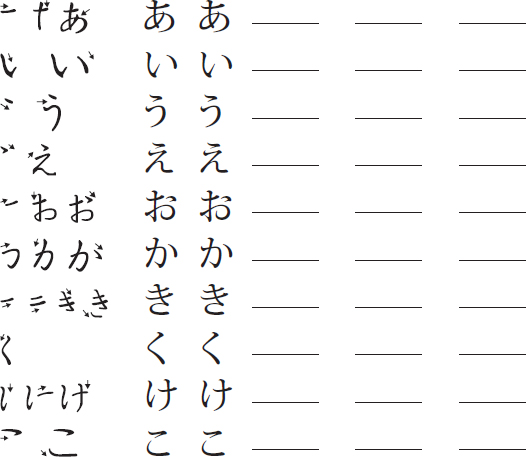

Read the following sequences of hiragana, row by row. Do not move on to a new row until you are able to read the current row very quickly. Repeat as many times as you need until you can read them very smoothly. You may try to read them backward for additional practice.


The following are some words that can be written using some of the first 10 hiragana characters. Read them aloud. For a greater challenge, cover the romaji as you work on this exercise. You may find it strange to have multiple syllables that are just vowels within a word, so watch out!
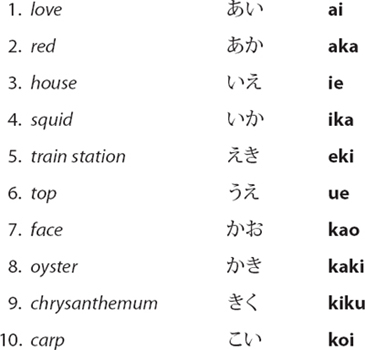

Write the hiragana for the following words. Refer to the romaji in the table on page 1.
The second 10 hiragana characters include five syllables with the consonant s and five syllables with the consonant t. When the vowel is i, we get shi and chi rather than si and ti. When the vowel is u, we get tsu rather than tu.

Practice writing the second 10 hiragana characters, paying attention to the order and direction of the strokes. Note that the second and the third strokes of the hiragana  sa are connected in some fonts, as in
sa are connected in some fonts, as in  , appearing like a mirror-image of the hiragana
, appearing like a mirror-image of the hiragana  chi, but they are usually separate when this character is handwritten.
chi, but they are usually separate when this character is handwritten.
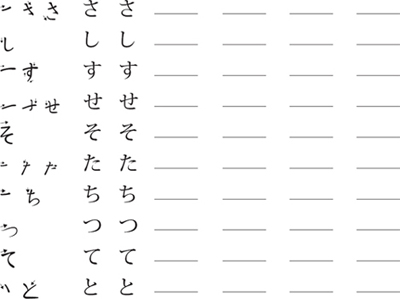

Read the following sequences of hiragana, row by row. Do not move on to a new row until you are able to read the current row very quickly. Repeat as many times as you need until you can read them very smoothly. You may try to read them backward for additional practice.


The following are some words that can be written using some of the first 20 hiragana characters. Read them aloud. For a greater challenge, cover the romaji as you work on this exercise.


Write the hiragana for the following words. Refer to the romaji in the table on page 1.
The third 10 hiragana include five syllables with the consonant n and five syllables with the consonant h. However, remember that  is not pronounced as hu but as fu.
is not pronounced as hu but as fu.

Practice writing the third 10 hiragana characters, paying attention to the order and direction of the strokes.


Read the following sequences of hiragana, row by row. Do not move on to a new row until you are able to read the current row very quickly. Repeat as many times as you need until you can read them very smoothly. You may try to read them backward for additional practice.


Read the following words, which are written using some of the first 30 hiragana characters. For a greater challenge, cover the romaji as you work on this exercise.


Write the hiragana for the following words. Refer to the romaji in the table on page 1.
The remaining 16 characters in the table on page 1 include five syllables with the consonant m, three syllables with the consonant y, five syllables with the consonant r, and wa and n. In Japanese, the y sound does not contrast meaning when placed before the vowels i or e. That’s why yi and ye are missing from the hiragana table. Similarly, the consonant w can contrast meaning only if it appears before the vowel a in the hiragana system. That’s why wi, wu, and we are missing from the hiragana table. Wo ( ) does appear in the table, but it is used only for the direct object particle, and it actually sounds like o. As discussed earlier, the Japanese r is very different from the English r. It is closer to the English l but not quite the same. The consonant n can form an independent syllable (or mora, in linguistic terms). Note that the two strokes of the hiragana
) does appear in the table, but it is used only for the direct object particle, and it actually sounds like o. As discussed earlier, the Japanese r is very different from the English r. It is closer to the English l but not quite the same. The consonant n can form an independent syllable (or mora, in linguistic terms). Note that the two strokes of the hiragana  ri are connected in some fonts, as in
ri are connected in some fonts, as in  , but they are usually separate when this character is handwritten.
, but they are usually separate when this character is handwritten.

Practice writing the last 16 hiragana characters, paying attention to the order and direction of the strokes.


Read the following sequences of hiragana, row by row. Do not move on to a new row until you are able to read the current row very quickly. Repeat as many times as you need until you can read them very smoothly. You may try to read them backward for additional practice.

Now that you are familiar with all of the basic kana characters, you can combine them into some basic Japanese words.
Many of the vocabulary words for body parts are easy to pronounce. Practice saying each one as you point to the appropriate part of the body.

As you practice saying these Japanese words for nature, picture them. For example, as you say  , picture rain falling.
, picture rain falling.


Choose the correct English translation from the options in parentheses.

Match the Japanese words and their English counterparts.

Write the following words in Japanese.
Here you will learn how to represent double consonants and long vowels, and then you will see them used in words that Japanese use to address older family members.

To represent the brief abrupt pause found in double consonants, use the small  . For example, kitte ( postage stamp) is written as
. For example, kitte ( postage stamp) is written as  .
.
Together, a hiragana character and the vowel o followed by  u jointly form a syllable that sounds like the long vowel
u jointly form a syllable that sounds like the long vowel  . So,
. So,  (father) is read as ot
(father) is read as ot san. Similarly, a hiragana character with a vowel e followed by
san. Similarly, a hiragana character with a vowel e followed by  i jointly form a syllable that sounds like the long vowel
i jointly form a syllable that sounds like the long vowel  . For example,
. For example,  (teacher) is read as sens
(teacher) is read as sens . (However, in this book,
. (However, in this book,  in such cases is still specified as ei in romaji, as in sensei, following the common practice in most romaji Japanese dictionaries.)
in such cases is still specified as ei in romaji, as in sensei, following the common practice in most romaji Japanese dictionaries.)
The Japanese address their older family members by using the following kinship terms, although they address their younger family members by using their given name or nickname.


Read the following words written in hiragana aloud. For a greater challenge, cover the romaji as you work on this exercise.


Write the following words in hiragana.
Two diacritics,  and
and  , are used to represent additional syllable sounds that can contribute to the meaning of Japanese words. Here you will learn how to use these diacritics and then see them used in some Japanese food terms.
, are used to represent additional syllable sounds that can contribute to the meaning of Japanese words. Here you will learn how to use these diacritics and then see them used in some Japanese food terms.
 and
and 
By adding the diacritic mark  at the upper-right corner of a certain character, you can indicate that its beginning consonant is voiced. By adding the mark
at the upper-right corner of a certain character, you can indicate that its beginning consonant is voiced. By adding the mark  at the upper-right corner of a certain character, you change its beginning consonant to p. Note that
at the upper-right corner of a certain character, you change its beginning consonant to p. Note that  changes h and f to b. The syllable ji is usually represented by
changes h and f to b. The syllable ji is usually represented by  , and it is also represented by
, and it is also represented by  in limited cases. Similarly, the syllable zu is usually represented by
in limited cases. Similarly, the syllable zu is usually represented by  , and it is also represented by
, and it is also represented by  in limited cases. The following table shows which characters they are combined with and how they are read:
in limited cases. The following table shows which characters they are combined with and how they are read:

Japanese food is popular overseas. You might see some of the following on the menu at a Japanese restaurant in your country:


Practice writing the following Japanese words.

Palatalized sounds are pronounced with the body of the tongue raised toward the palate. Here you will learn how to represent these sounds and see their use in familiar Japanese words.
 ya,
ya,  yu, or
yu, or  yo
yoTo express a palatalized sound like kya or hyu, use a character that represents the initial consonant and the vowel i and then add small-sized  ya,
ya,  yu, or
yu, or  yo, depending on the vowel needed. The following table shows how to represent palatalized syllables in both hiragana and katakana:
yo, depending on the vowel needed. The following table shows how to represent palatalized syllables in both hiragana and katakana:
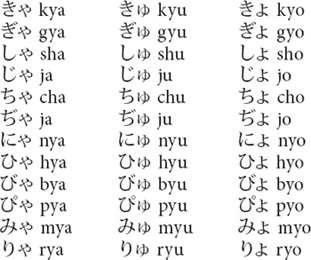
The following words related to Japanese culture might be already familiar to you:


Write the following words in Japanese, using hiragana.

Read the following place names written in hiragana and guess what they are.
Each hiragana character was created by simplifying or deforming some kanji character, and each katakana character was created by taking a part of some kanji. Whereas hiragana characters have more curved lines, katakana characters have more straight lines and angles. The following table shows pairs of hiragana and katakana and the stroke order of katakana characters:


Look at the preceding table and list the katakana characters that conform to the following descriptions.
1. Katakana characters that have only one stroke: ____________________________________
2. Katakana characters that have two separate simple horizontal lines: ____________________
3. Katakana characters that look similar to the hiragana counterparts: ____________________

Read the following pairs of katakana characters and write out in Japanese. They look similar, so be careful.

Read the following words written in katakana and guess what they mean. Refer to the table on page 16, as needed.

Read the following words written in katakana aloud, paying attention to the diacritics.
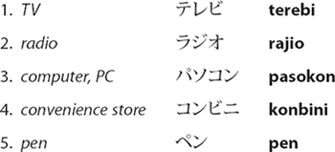

Read the following words written in katakana aloud, paying attention to long vowels and double consonants. Remember that the elongation mark ( ) represents a long vowel.
) represents a long vowel.

The katakana system allows some combinations of characters that are not available in the hiragana system because katakana is used to represent non-Japanese names and words. Examples include:
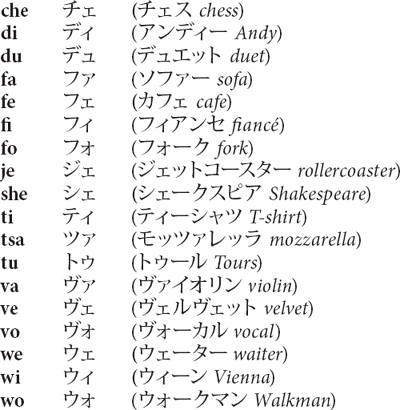
Country names are written in katakana. The exceptions are country names that are conventionally written in kanji. You or some of your friends may be from these countries.


Read the following city names written in katakana. For a greater challenge, cover the romaji as you work on this exercise.


Read the following words that name Western food and beverages. For a greater challenge, cover the romaji as you work on this exercise.


Write the following country names in katakana.
Here are some rules for writing Japanese sentences:
 , and the Japanese comma is
, and the Japanese comma is  or
or  .
. is used only as a participle marking a direct object in modern Japanese. The character
is used only as a participle marking a direct object in modern Japanese. The character  is pronounced as o, just like
is pronounced as o, just like  . Some people pronounce
. Some people pronounce  as wo when reading a kana chart, but they still pronounce it as o in sentences.
as wo when reading a kana chart, but they still pronounce it as o in sentences. is used as a topic marker, its pronunciation is wa rather than ha. When the character
is used as a topic marker, its pronunciation is wa rather than ha. When the character  is used as a direction-marking particle, it is read as e rather than as he.
is used as a direction-marking particle, it is read as e rather than as he.
Read the following sentences out loud. For a greater challenge, cover the romaji as you work on this exercise.
1. 
Emir wa sushi o tabemashita.
wa sushi o tabemashita.
Emily ate sushi.
2. 
Bosuton e ikimasu ga, tomarimasen.
I’ll go to Boston but won’t stay there overnight.
Most kanji characters can be pronounced in both Japanese and Chinese ways. For example, the Japanese way of pronouncing  is hito, and the Chinese way of pronouncing it is nin or jin. There is no standard rule for the difference, so you need to learn each one individually. In this book, romaji shows how kanji characters are read in each phrase and sentence.
is hito, and the Chinese way of pronouncing it is nin or jin. There is no standard rule for the difference, so you need to learn each one individually. In this book, romaji shows how kanji characters are read in each phrase and sentence.
The following table shows some simple kanji characters that are frequently used as components of other kanji characters:
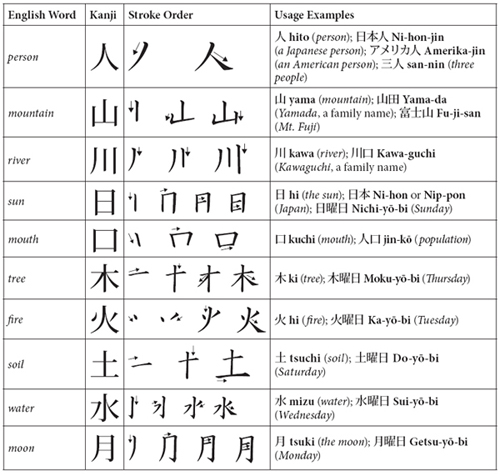
Kanji characters that represent verbs and adjectives need to be followed by hiragana that show inflectional endings, as in  kaku (write) and
kaku (write) and  kaita (wrote). The following are some frequently used verbs written in kanji and hiragana. A dash in romaji separates the portion that represents kanji and the portion that represents hiragana.
kaita (wrote). The following are some frequently used verbs written in kanji and hiragana. A dash in romaji separates the portion that represents kanji and the portion that represents hiragana.

The following are some frequently used adjectives written in kanji and hiragana:


Practice writing the following basic kanji characters, using the correct stroke order.
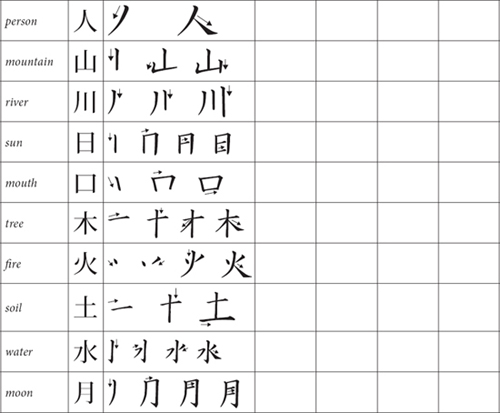

The following words are written in kanji followed by hiragana in parentheses. Write the English equivalent for each one.